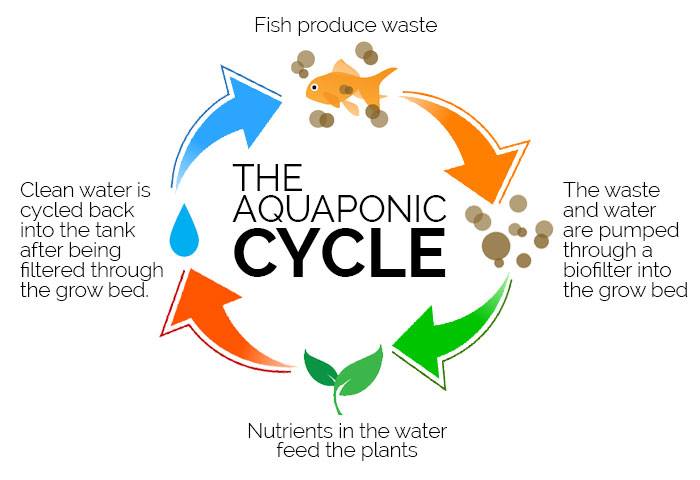What happens when you mix fish farming with hydroponics? Aquaponics!
If you’re new to the subject, this type of food production can be an amazing resource. I think of it a bit like hacking nature. Aquaponics takes all of the primary needs of a plant and animal ecosystem and compresses them in to one cyclic package. It’s basically poo powered hydroponic gardening with the extra benefit of having tasty fish to eat. This combination creates a closed-loop environment where fish and plants thrive together.
How Aquaponics Works
In aquaponics, the fish are housed in a tank and the plants are grown in a grow bed. The nutrient-rich water from the fish tank is pumped to the grow bed, where it is filtered through the plant roots. The beneficial bacteria that live in the grow bed break down the fish waste into ammonia, which is then converted into nitrites and then nitrates. The plants absorb these nitrates and other nutrients to help them grow. The plant roots also help to oxygenate the water, which is important for the health of the fish.
The clean water from the grow bed is then pumped back to the fish tank, where the cycle begins again.

Benefits of Aquaponics
Aquaponics offers a number of benefits over traditional farming methods. It is a more sustainable way to produce food, as it uses less water and fertilizer. It is also more efficient, as the fish waste is recycled to fertilize the plants. Aquaponics systems can be used to grow a variety of fruits, vegetables, and herbs, both indoors and outdoors.
Here are some of the specific benefits of aquaponics:
- Sustainability: Aquaponics systems use less water and fertilizer than traditional farming methods. They also produce less waste.
- Efficiency: Aquaponics systems are more efficient than traditional farming methods, as the fish waste is recycled to fertilize the plants.
- Versatility: Aquaponics systems can be used to grow a variety of fruits, vegetables, and herbs, both indoors and outdoors.
- Organic production: Aquaponics systems are naturally organic, as no synthetic fertilizers or pesticides are needed.
- Healthier food: The food grown in aquaponics systems is often healthier than food grown in traditional farming methods, as it is not exposed to synthetic chemicals.
The video below is a quick 1 minute explanation of our system in Costa Rica
Our System In Costa Rica
It’s known as a CHOP system, (constant height one pump). It runs on a 130 watt pump. Gravity does the rest of the work. High stocking densities of fish can be grown in an aquaponic system, and because of the recirculating nature of the systems very little water is used. Research has shown that an aquaponic system uses about 10 percent of the water needed to grow vegetables in traditional dirt gardening. Our first system had 50 tilapia in only 1000 liters! We built it using resources from the UN FAO Aquaponics Food Production Manual.
In dry areas such as Northwest Costa Rica, aquaponics could be a solution for the water usage issues. We’re currently using Tilapia in one tank and and Swai (Aka Basa, Vietnamese river shark, tra, or sutchi) in the other.




GIPHY App Key not set. Please check settings
One Comment